Markha Valley trek: How to do it independently
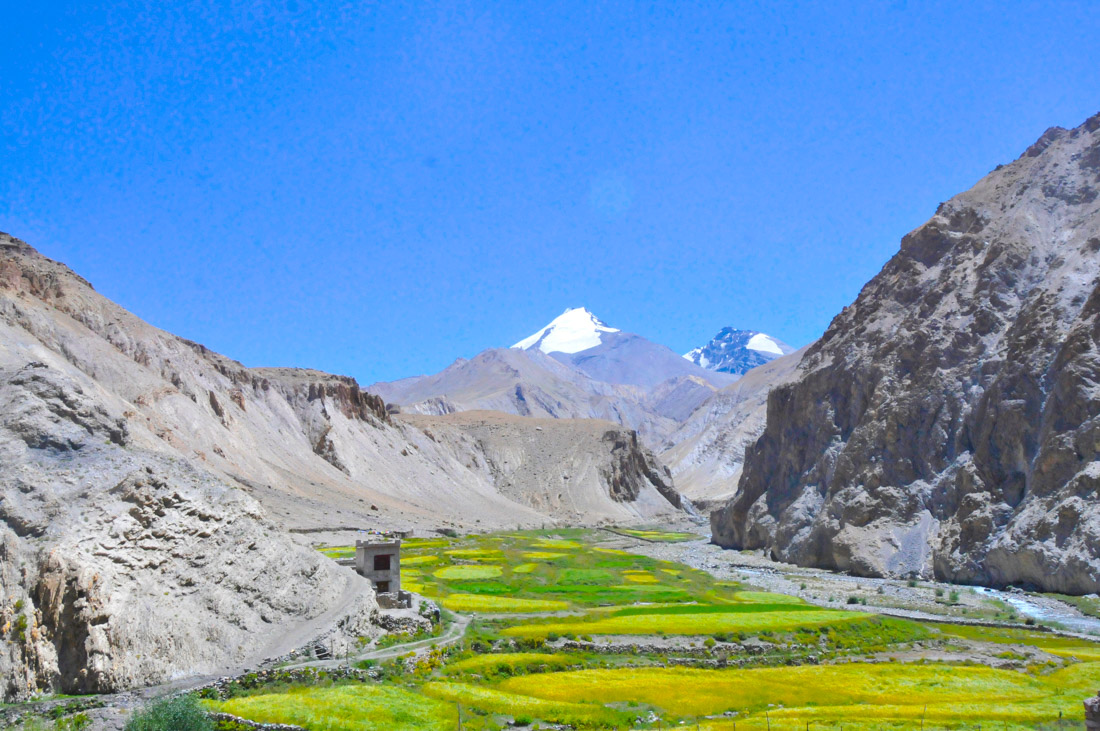
Yaks grazing on green plains at an altitude of 5,000m, white snow-covered peaks higher than 6,000m, extensive valleys surrounded by huge, rocky mountains and a strong Tibetan culture with deep roots: the Markha Valley trek is the perfect hike for those seeking both stunning Himalayan landscapes and experience real Tibetan culture.
Markha Valley is one of the most popular treks in Ladakh, but it’s still a hundred times more authentic than the popular treks offered in Nepal.
Tourism in Ladakh is still emerging and, today, you can walk around Markha for hours and yet not meet any soul apart from Tibetan shepherds.
Keep reading: A travel guide to Ladakh
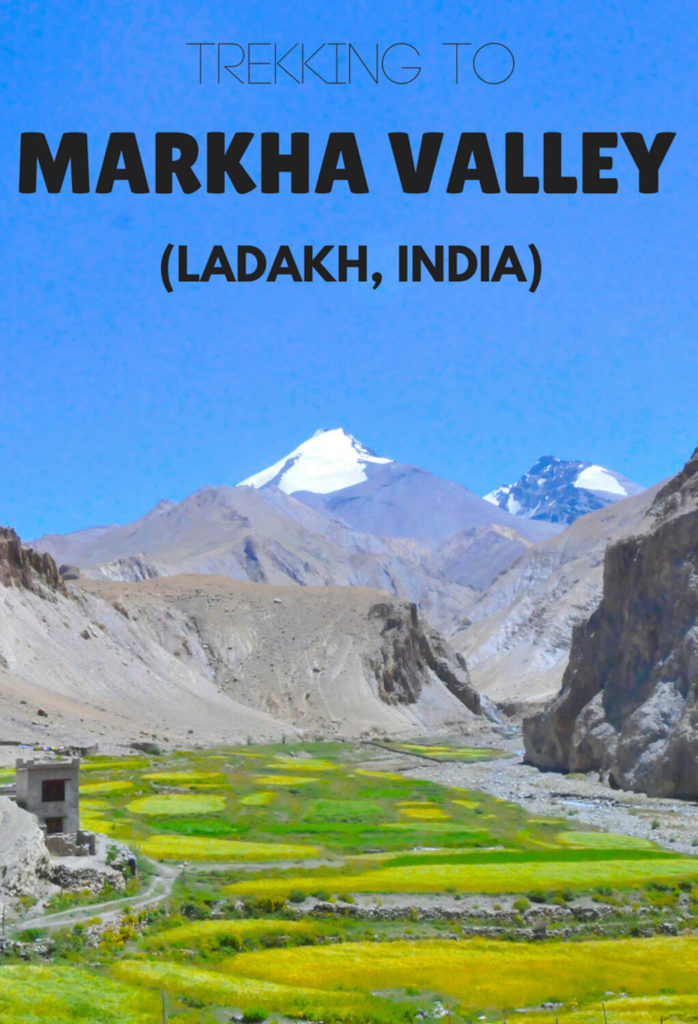
The Markha trek goes alongside a river called Markha, a tributary of the Zankskar. This river is surrounded by big, rocky mountains which give shape to the valley.
Along the valley, there are numerous Tibetan settlements that have turned into small villages, made of mud-brick houses, and Buddhist gompas.
For centuries, this region was totally isolated from modern society, until it was discovered in the 19th century.
Today, Tibetans from Markha Valley make a living from the few trekkers that pass by during the summer months.
What are you going to find in this guide?
Trekking details
Length: 96km / 50km
Duration: 4-9 days
When to go: June to September
Highest point: 5,200m
Lowest point: 3,200m
Difficulty: Medium (experienced beginners)
How many days are needed to complete the Markha Valley hike?
You need a minimum of 4 days and a maximum of 9, depending on where you start from:
Spitok – Starting from Spitok involves walking for between 6 and 9 days. During the first 2-3 days (40km), you walk through rocky areas until you cross Ganda La pass, at 4,970m. From there, you start descending until you get into the actual Markha river.
Chilling – This place is located on the Markha river itself, which means that you skip the first 2-3 days needed to get there. From Chilling, trekkers take between 4 and 6 days to complete the trail. That’s the option I chose.
Read: A beginner’s guide to trekking in Kyrgyzstan

Do you need a guide to complete the Markha Valley trek in Ladakh?
No, you don’t need a guide at all. You can do it independently without any problem. Let me tell you why:
The key is to follow the horse shit – It seems like a joke but, actually, there is plenty of horse shit along the trail, which will tell you the route to follow. Locals use these animals as a way of transportation when moving between villages.
Shepherds and local Tibetans – If animal manure disorientates you, don’t worry because, along the way, you will meet loads of shepherds, with their herd and their horses, who you can ask for directions.
Tibetan villages – Additionally, you will encounter villages every 2-4 hours, where you can also ask whether you are going in the right direction or not.
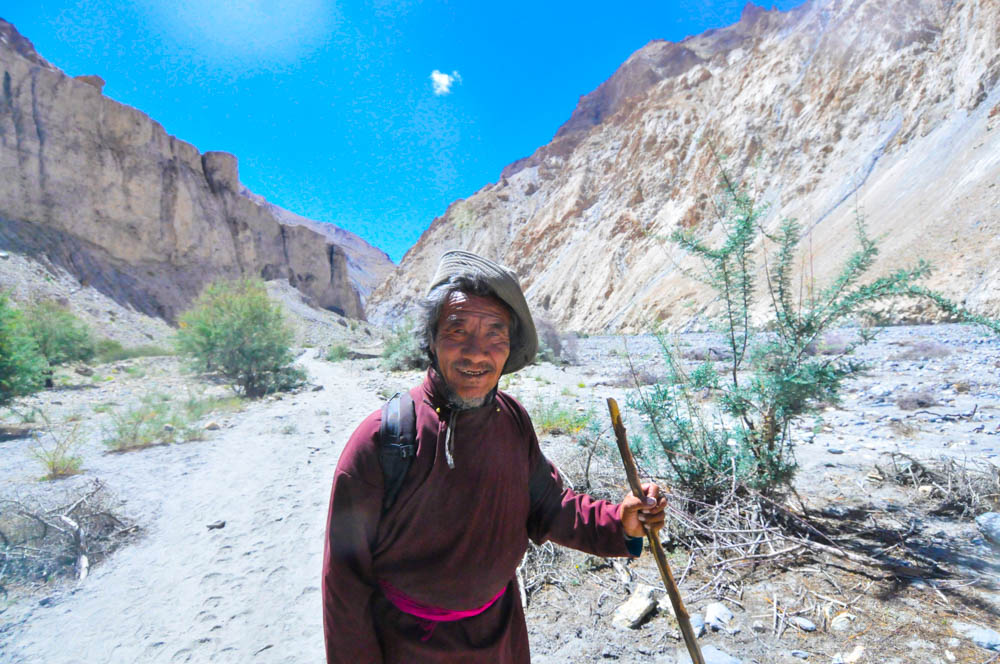
Markha Valley trek cost: Price with guide vs price by yourself
Price with guide
I asked several trekking agencies in Leh and, as an average, this would be the price for one person. If you were with more people, it would decrease slightly, obviously:
4 days x 4,000INR per day = 16,000INR (240USD)
It includes:
A guide
Round trip transportation
Accommodation in either homestay or tent
3 meals a day
Price without a guide
Transportation from Leh to Chilling – A taxi costs around 2,800INR (43USD). If you don’t have anyone to share it with, I suggest you find a local who can you take there by motorbike. I paid 1,500INR (23USD).
Accommodation and food – Both homestay and tents cost 1,200INR (16.50USD), including dinner, breakfast and a picnic lunch box.
Transportation back to Leh – Taxis from Shang Sumdo (the ending point) to Leh cost 2,500INR (40USD). However, occasionally, early in the morning, you can find local transportation. I paid 500INR (8USD).
Total Cost = 1,500INR + 4 days x 1,200INR + 500 = 6,300INR (87USD)

Transportation: How to get there and back?
From Leh to Chilling
Chilling is located 65km from Leh and it takes around 1 hour and 20 minutes to reach it. Taxis can easily be booked for 2,800INR ($43).
If you can’t find anyone to share it with, unofficially, you can find a motorbike taxi. How? Just ask at the different agencies.
Most of them will tell you that they don’t offer this service but keep asking until you find one. I paid 1,500INR ($23).
From Shang Sumdo to Leh
Shang Sumdo is the ending point of the Markha Valley trek and the first village which vehicles can reach. There are taxis expecting to take you to Leh for 2,500INR ($43).
Once again, if you are just by yourself, you can either wait for other trekkers to come or go back to Leh by public transportation.
Occasionally, there are local taxis leaving at 6am. You just need to be lucky. Ask anybody around for this information.
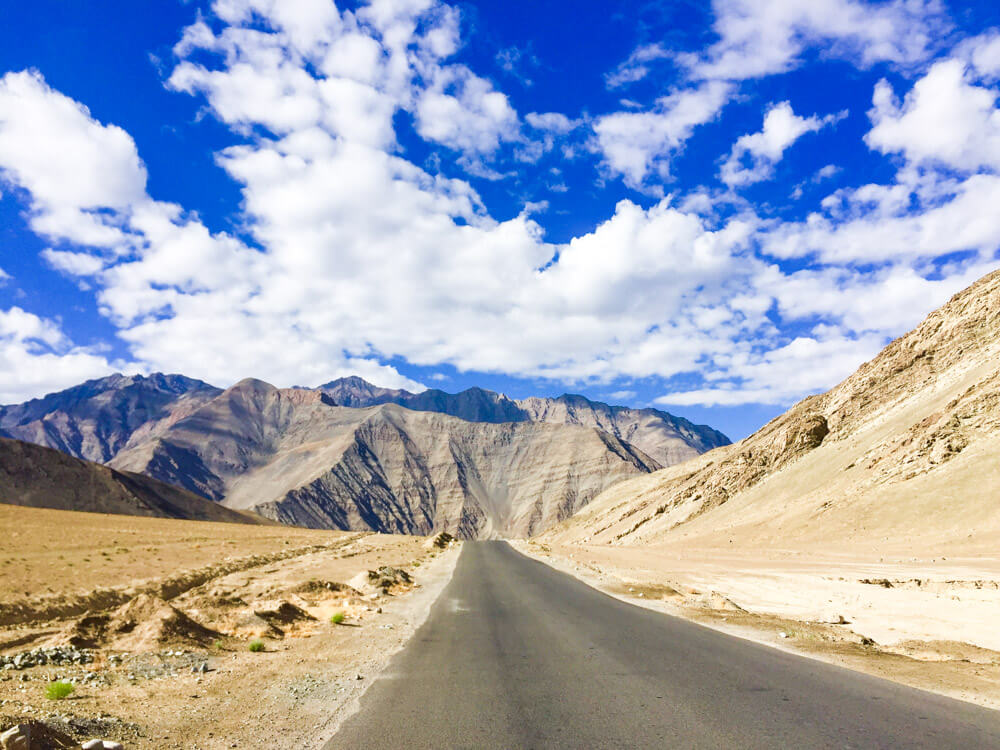
Markha Valley trek map (Ladakh)
Markha Valley trek itinerary: Day by day route
Please note that the following day by day itinerary starts from Chilling, which is the one I followed.
Day 1: Chilling – Sara
Length: 19km
Duration: 8hr
Highest point: 3,710m
Lowest point: 3,200m
On the first day, the tough part is only during the first 5km, where you need to climb until you reach the Markha Valley itself. Afterwards, it becomes completely flat.
You’ll pass some villages, the biggest one being Skyu, where you can get a cooked meal.
The river flows through a valley which becomes greener as you keep going, but the aggressive surrounding mountains are brownish and arid.
Sara is a village comprised of just a few houses where you can find a few homestay options. However, I didn’t sleep there, but in a beautiful campsite located just a few kilometers before. It was set up on a green plain, the perfect spot to spend the night, chill out and meet other trekkers.

Day 2: Sara – Markha
Length: 8km
Duration: 4hr
Highest point: 3,850m
Lowest point: 3,710m
This is the shortest, flattest and most relaxing part of the whole hike. The landscape is pretty similar to that of the previous day, but the mountains are sharper.
Honestly, you could easily continue walking to a further village, but Markha is sort of a special place, worth spending half a day in.
It’s the capital of the valley, hence the village with more things to do and see, from a couple of Buddhist gompas, to peasants working in the fields, playing with children or admiring the landscape.
By the way, don’t expect Markha to be a metropolis, as it is composed of no more than 20 houses spread around a big area.
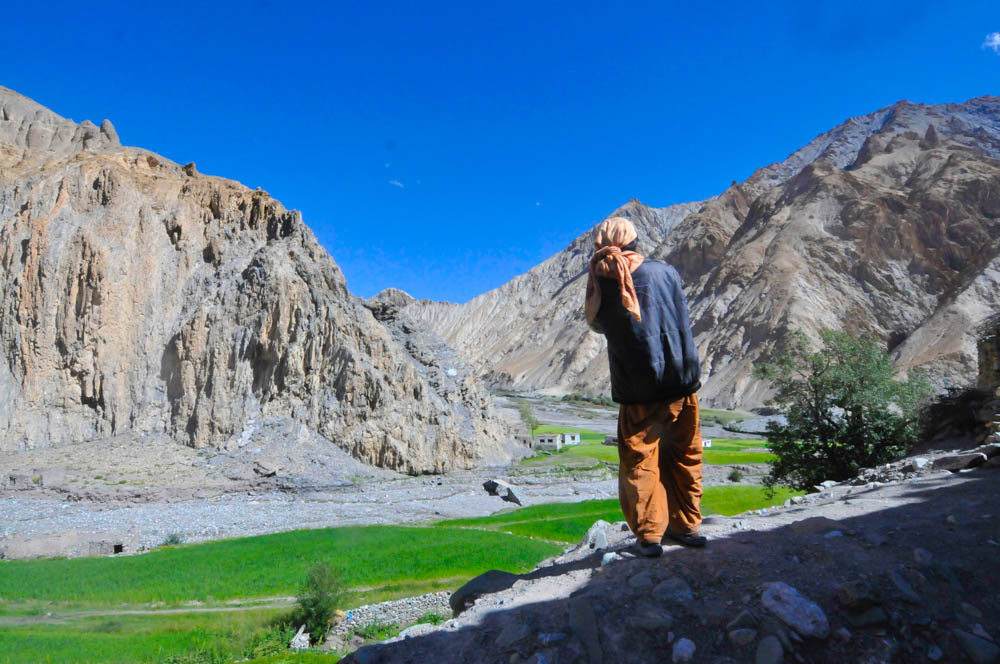
Day 3: Markha – Thachungtse
Length: 12.5km
Duration: 6hr
Highest point: 4,300m
Lowest point: 3,850m
On the third day, things start to become really interesting. Just a few hours after Markha, you can make out Kang Yaze peak, a mountain 6,150m.
If you are lucky, you can also spot some Himalayan deer. You need to keep following the valley until Hankar, situated at the half-way point, and where you can also get a warm meal (or spend the night if you like).
When you leave Hankar behind, you need to get off the valley by turning left at some point. Don’t worry, you can’t miss it.
From there, the trail becomes tougher than ever. You will have to ascend 500m in just a few kilometers before reaching Thachungste.
The views are superb, especially because you are getting closer and closer to Kang Yaze.
Thachungste is a camping site at above 4,300 meters, placed just next to a mighty river and where hundreds of strange, tiny rabbits wander all over the place.

Day 4: Thachungste – Nimaling – Shang Sumdo
Length: 20km
Duration: 11hr
Highest point: 5,200m
Lowest point: 3,810m
The toughest part of the whole trek but, at the same time, the most rewarding. Most hikers split this stage into two and spend one night in Nimaling. I decided to do it in one day. It depends on you.
The first stretch from Thachungste to Nimaling is breathtaking.
You ascend from 4,300m to 4,800m in just 9km, passing herds of yaks and hairy Himalayan horses and very authentic Tibetan shepherds.
The landscape has loads of contrasts and, at one point, you can look to your left and see a green field with Kang Yaze in the background and to the right, gray and purple rocky mountains.
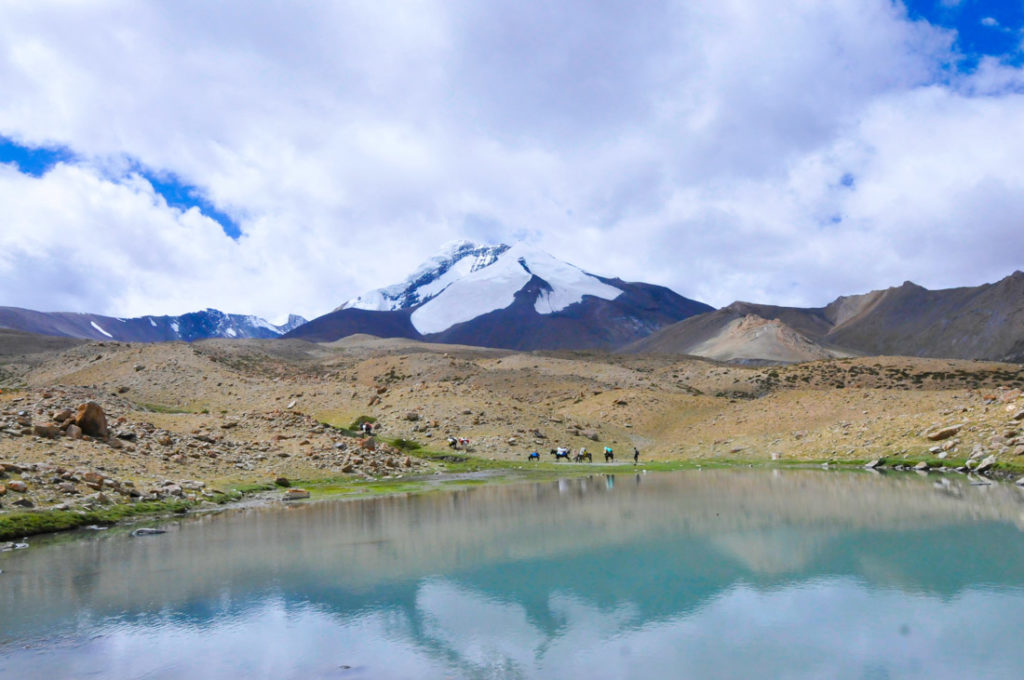
Nimaling is located in a huge green plain, full of yaks. There’s quite a big campsite set up. At a normal pace, you might reach Nimaling in 3hr. You can either spend the night here or continue walking.
As soon as you leave the plains of Nimaling, you start directly going up to Gongmaru La pass, located at 5,200m and the highest point of the trek.
The ascent is hard but the views you get both right and left are impressive. When you finally reach the top, recover your breath, rest for an hour and enjoy the views.
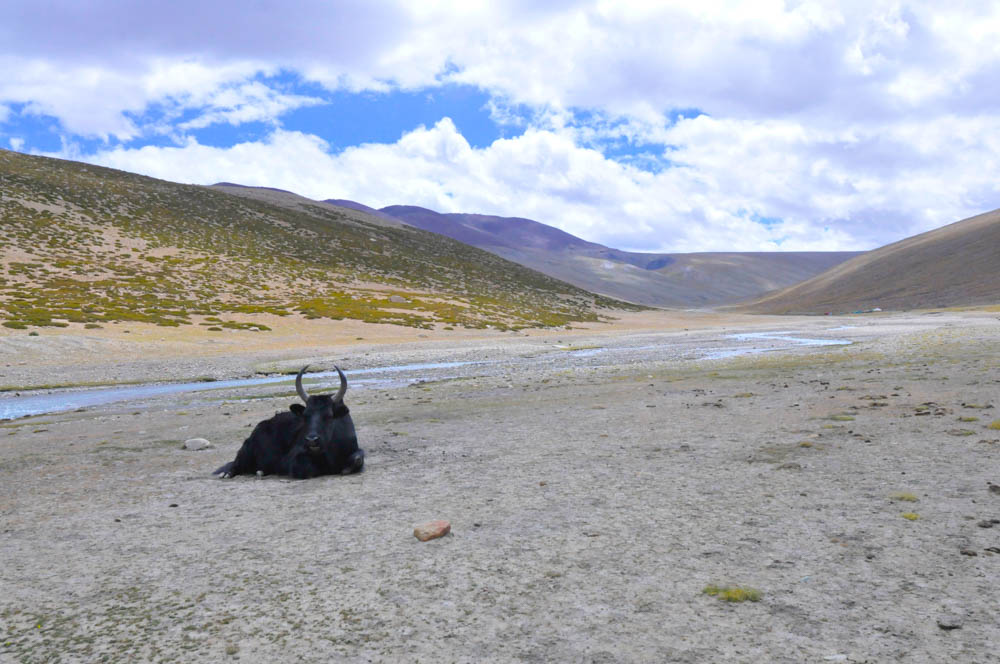
After the pass, you just need to go down. The way is extremely steep and you have to descend 1,500m in just 4hr. At the end of the trail, you get to a river which flows through a valley.
Follow it and, after 4hr, you should reach the end point, Shang Sumdo.
The trail is a bit confusing since sometimes, the way is blocked and you need to go over the valley but then go down again.
Once you are in Shang Sumdo, have a rest over a couple of beers. From here, you can go to Leh by car.
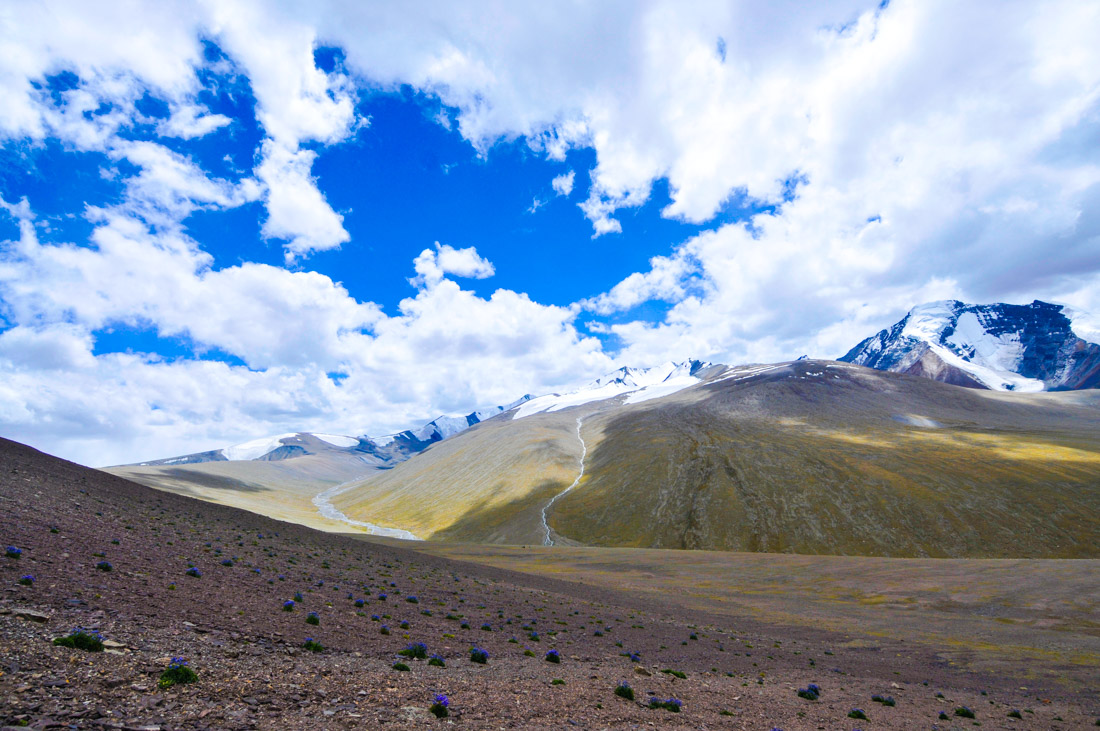
Accommodation
Unless you are bringing your own tent, there are two types of accommodation:
Homestays – Most Tibetans have a spare room with 3 to 4 mattresses on the floor for trekkers. They charge you 1,000INR ($15) including dinner, breakfast, a picnic lunch box and all the tea and cookies you want. If you are lucky, the family will invite you to sit with them for dinner. Some of them will make the effort and try to start a conversation, even though their English is not good.
Camping sites – Along the route, Tibetans have set up exclusive campsites for trekkers. The price is also 1,000 rupees per tent, including meals as well. Tents are well-prepared and have a thick mattress and blankets.

Food, water, and showers
Food – As you would expect, food is, definitely, not the highlight of this trek. In homestays, they will always serve you dal (lentils) and rice and chapati (flat Indian bread) with jam and butter for breakfast. The picnic lunch box consists of a slice of bread, some cheese, a potato and one piece of fruit. If you are very lucky, you might get some eggs for breakfast. In the villages, you can get some extra dishes, such as instant noodles or skyu, a traditional Tibetan dish consisting of stew with flour balls.
Water – Bottled water is not sold across Markha Valley, but they drink from the river. The water you buy has previously been boiled and filtered by the locals. It costs 15INR (23¢) per liter. Bring your own bottle.
Shower – There are no showers. If you want to wash, you should go to the river. Furthermore, the few toilets you find are holes on the ground. Personally, I prefer going into the bushes.
Markha Valley trek: Packing List
Travel Insurance – In the mountains, accidents do happen. Remember to always have insurance. I strongly recommend buying World Nomads.
A backpacking tent for high altitude mountains – If you don’t want to pay for accommodation, bringing your own tent, will make things much cheaper. I recommend a Freelite 2, which is the one I bought in 2017.
A warm sleeping bag – At high altitudes, nights can be freezing. I recommend a Kelty Cosmic 20º, which I bought in 2017, as well.
A camping stove – To save yourself from buying non-tasty meals, bring your own cooking equipment and stock up on supplies in Leh. If I was you, I would get a multi-fuel stove, which works with any kind of flammable liquid, such as white gas, pure alcohol, gasoline, and diesel. I recommend you buy the MSR XGK EK multi-fuel stove.
For purifying water – Supposedly, the water sold by the locals is boiled but, if you are not entirely sure about it or you just don’t want to pay for mountain water, you should always bring purifying tablets or a Steripen.
Warm clothes – From proper hiking pants to a warm jacket and thick socks. As I said before, nights can be freezing at above 4,000 meters.
A Kindle – If you don’t have a Kindle, perhaps, it’s time to buy one. At night, you will have nothing to do but read and you know that books are heavy to carry.
Solar protection – As you keep on ascending, you also get closer to the sun, hence its rays become more lethal. Please note that in August, the sun is extremely strong.
A hat or a cap – The sun is extremely harsh, especially in summer.
Diamox – High altitude sickness is very common among travelers who go to Ladakh. Why? Because most of them reach Leh by plane, which is already at 3,500m. The altitude change is too drastic and some hikers don’t have enough time to acclimatize. Before going to Markha Valley, I would spare 3 or 4 days resting in Leh. For the trek, bring Diamox with you, which is a medicine that helps to fight against altitude sickness.
Keep reading:
The ultimate guide to travel to Ladakh
Top 100 outdoor blogs
If you like my website and found this post useful, remember that, if you book any service through any of my links, I will get a small commission at no extra cost to you. These earnings help me maintain and keep Against the Compass going! Thanks 🙂

28 comments
Hi Joan,
How about that dude living solo at 4500 meters?
I always appreciate folks who live alone in remote outposts. They have mastered this fear of being alone, and lonely, as we are social creatures who crave connection, at least after a few weeks or months.
I lived 3 hours away from civilization in the jungle a few years ago. Nothing like these remote spots you write of up top, but still, the 1 dude who lived down the road was someone I admired. He spent most of his life in the jungle with animals, versus in town with humans, save 1 day a week. Impressive.
Brilliant pictures Joan.
Ryan
Hey!
Just some news one year later about that Valley, I did the trek the last week of September. Some more info for readers coming till that comment part 🙂
Pros: we were no more than 3-5 foreigners sleeping in the main villages(sky, Markha, nyimaling camp), perfect for talking to locals. No organise group anymore!
Cons: it’s getting cold (-5 nyimaling) and camps are closing
About itinerary, I skipped a day too, but by walking from Markha to nyimaling in a day(7.5hrs) witch is hard but doable
Something else, if you have time, don’t skip the part between zinchen and skyu, the first pass is incredible and the way down to skyu too!
Hoped I helped some.
Hi Leroy, thanks for your tips man! Yes, it was definitely useful. Good to know that they are starting to close camps the last week of September. And yes, perhaps I should encourage people to do the first pass 🙂 I hope you enjoyed man!
Just reading through these lines really have me excited about my upcoming trip to Leh! Is there a specific guide/company you would recommend? Is it better to book in advance or only once on site? Thanks so much for your help!
Hi Val, I went there independently so can’t recommend a specific tour company. However, in order to know the prices which are shown in this article, I asked several agencies and all of them were asking for the same price, more or less. You MUST book it once you are in Leh. You will save 50% of your money and don’t worry, because there are dozens of different trekking agencies. Go there and, on the first or second day, just ask at 4 or 5 agencies and choose your favourite one :9 Cheers,
Hi, thank you for the great summary of the trek! I am going to Leh during my world travel and therefor I wanted to ask if you brought all your equipment from home or did you buy it in Leh (I heard you can get everything there for a fair price). I would be travelling in warm regions before going there, so I am not that much into carrying everything with me for months…
Thank you,
Mario
Hi Mario, yes, you can buy it in Leh but the quality won’t be as good. For example, you can buy a super warm sleeping bag which could keep you warm at -8ºC but it is going to weight 5kg. It’s always better to buy the brands you like in your home country. Cheers!
Hey Joan!
Thank you for this great description! We are gonna do this trek in June.
We won’t bring a tent en would like to spend the nights at the homestays as you described.
Do we also need a warm sleeping bag over there? Or do they have enough blankets?
I would like to go with a light down sleeping bag and a fleece liner. Do you think that will be okay?
Thank you so much!
Loore
Hey Loore, they have extremely warm blankets, no need to worry about that 😉
Hi Loore,
We are also doing this trek in June! Do you have an itinerary yet? I am so excited. Can’t wait till June 🙂
Teresa
Hi Teresa, in June we will be around the Caucasus. You meant my itinerary, right? Otherwise, the trekking itinerary in on the post, if that is what you were asking 😉
Hello. This has been a very interesting and informative read. Can this trek be joined at Chilling through the Hemis National Park?
I am not sure to be honest
Hi
Really nice information about trek.
I just want to ask if your tips and advice are valid for longer version of Markha Valley Trek (7-8 days from Spituk).
I would like to walk a longer option sleeping in homestays.
As I understand no GPS needed. Just a map.
Thanks.
Darius
Hey Darius, yes, they definitely are valid for the longer route
Hey!
Thanks for the detailed info. Just some question about what to bring and where to sleep. I plan to do the Markha valley independently in early June but in reverse to go up to Stok at the end.
Are home stays comfortable or should I bring a lightweight mattress? (I saw in another comment that warm blankets were no problem). And I don’t need to bring a tent right?
Als for the food should I bring a stove? From what I understood the food there is not amazing.
Cheers
Kevin
Hi Kevin, there are homestays and campsites along the way, so you should be fine.
As per the food, well, it is very simple food, like daal and rice mainly, but I don’t think you are going to cook much better with a simple camping stove
Hello,
My gf and I are planning a trip to Leh to hike Ladakh in july. We are vers confused abort the weather as we read a lot of different infomation and advice when and when not to travel. How will the weather usually be in july and can you recommend the Markha Valley in this month?
Hi John, July is the best month of the year to trek the Markha Valley
Hello,
From my research, Mid-June to september are treakking seasons in Leh. Can you do the Markha Valley trek in and around last week of August ? Also about the guide availability,
can you get a guide for just one indiviual ? I tried asking around a few agencies over email and they were only doing “group tours”, not that I have a problem with that.
Hi Jimmy, if you look for an agency once you are in Leh, you’ll be able to find them. End of August is very doable.
Hi, we’re going to Ladakh at the end of August – do you think, there will be enough capacity in the homestays or in the campsites to stay , even though it will be the tourist season? Because I think Ladakh’s treks have become more popular these days…
And one more question – is it necessary to bring our own mosquito net?
Thanks 🙂
Hi, there should be enough capacity. I don’t think they would allow someone sleep outside, if that person didn’t have a tent.
As per mosquito net, they didn’t provide you with one, so you can bring one along
Unfortunately the packing list is a bunch of hogwash.
The great thing about this trek is, you dont need a tent or a stove or food. You only need a thick sleeping bag in peak season, otherwise everywhere including Nimaling will have enough blankets.
I was mislead by this list and envied 95% of other trekkers who had much lighter load. At 5000m every kg makes a difference.
The packing list clearly states that if you don’t want to pay for accommodation, bringing your own tent will make things much cheaper and, to save yourself from buying non-tasty meals, bring your own cooking equipment and stock up on supplies in Leh.
Never said that those items were a must, so the fault is yours.
Hey Joan, thanks a lot for the great description!
My gf and I are planning to do the trek in June. I am wondering, do you need to reserve homestays (can you even?), or do just show up? You said in a previous reply that you think capacity would not be an issue, do you think that’s true in late June? Many thanks 🙂
UPDATE JUNE 2023
The small stream in the valley from Nimaling to Chogdo is overflowing with melting water at the moment. As there are 20+ river crossings it is extremely dangerous to descend that way. If you can avoid this part and have time to return the way you came up, do so!
After a really nice and easy trek up to Nimaling, we attempted to climb down from Nimaling to Chogdo on the 25th of June via the Konmaru La East Pass. The first bit after the pass, was steep and a little sketchy but well manageable with some experience and sturdy footwear.
Unfortunately after that we were facing massive amounts of water flowing down the valley to Chogdo. After crossing the river twice (slipping and falling, almost losing our backpacks and hiking poles) we decided to wait until the next morning as water levels were expected to go down during the night. Which means we got stuck halfway on the mountain at 4500 meters and ended up staying the night emergency bivouacing (sharing 3 sleeping bags and one emergency bivouac bag between the 7 of us). We were lucky to be a group of (semi-)experienced trekkers who could make it down safely the next morning starting at around 4.30 am.
Moreover, travel agencies and locals in the camp in Nimaling do not seem to care or do not know any better, so do not expect warning from their side. Also there is no reception on the descend and even satellite phones do not work as they’re blocked in Ladakh. Stay alert and safe!
You keep refering to them as Tibetans. They are not Tibetans, they are Ladakhi people from Ladakh, India.
Culturally though they are similar to Tibetans.